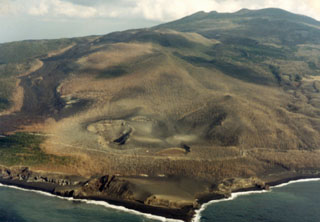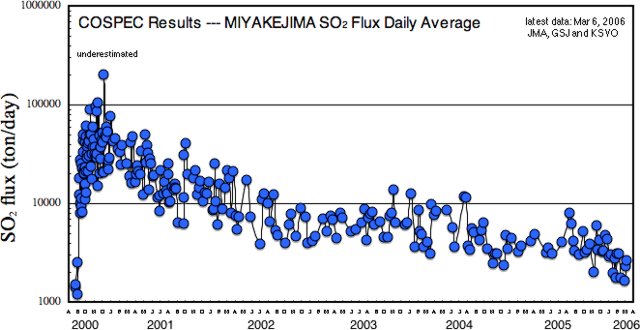Report on Miyakejima (Japan) — March 2006
Bulletin of the Global Volcanism Network, vol. 31, no. 3 (March 2006)
Managing Editor: Richard Wunderman.
Miyakejima (Japan) Ash emissions in February 2006; declining SO2 flux
Please cite this report as:
Global Volcanism Program, 2006. Report on Miyakejima (Japan) (Wunderman, R., ed.). Bulletin of the Global Volcanism Network, 31:3. Smithsonian Institution. https://doi.org/10.5479/si.GVP.BGVN200603-284040
Miyakejima
Japan
34.094°N, 139.526°E; summit elev. 775 m
All times are local (unless otherwise noted)
According to a news report, there was a minor eruption at Miyake-jima on 17 February 2006 that consisted of small ash emissions. Residents of the island were warned that there could be gas emissions and mudslides. The Geological Survey of Japan (AIST) website reported that the SO2 flux at Miyake-jima averaged about 2,000-5,000 tons per day in January 2006 (figure 22). The previous activity took place in November-December 2004, ending on 9 December 2004 when minor eruptions were reported after a two-year lull. As of mid-April 2006 no further activity had been reported.
Geological Summary. The circular, 8-km-wide island of Miyakejima forms a low-angle stratovolcano that rises about 1,100 m from the sea floor in the northern Izu Islands about 200 km SSW of Tokyo. The basaltic volcano is truncated by small summit calderas, one of which, 3.5 km wide, was formed during a major eruption about 2,500 years ago. Numerous craters and vents, including maars near the coast and radially oriented fissure vents, are present on the flanks. Frequent eruptions have been recorded since 1085 CE at vents ranging from the summit to below sea level, causing much damage on this small populated island. After a three-century-long hiatus ending in 1469 CE, activity has been dominated by flank fissure eruptions sometimes accompanied by minor summit eruptions. A 1.6-km-wide summit crater was slowly formed by subsidence during an eruption in 2000.
Information Contacts: Japan Meteorological Agency (JMA), Volcanological Division, 1-3-4 Ote-machi, Chiyoda-ku, Tokyo 100, Japan (URL: http://www.jma.go.jp/); A. Tomiya, Geological Survey of Japan (AIST), 1-1 Higashi, 1-Chome Tsukuba, Ibaraki 305-856, Japan (URL: https://staff.aist.go.jp/a.tomiya/miyakeE.html); Kazahaya Kohei, Geological Survey of Japan (URL: https://staff.aist.go.jp/kazahaya-k/miyakegas/COSPEC.html); Earthquake Research Institute (ERI), University of Tokyo, Yayoi 1-1-1, Bunkyo-ku, Tokyo, 113-0032, Japan.


